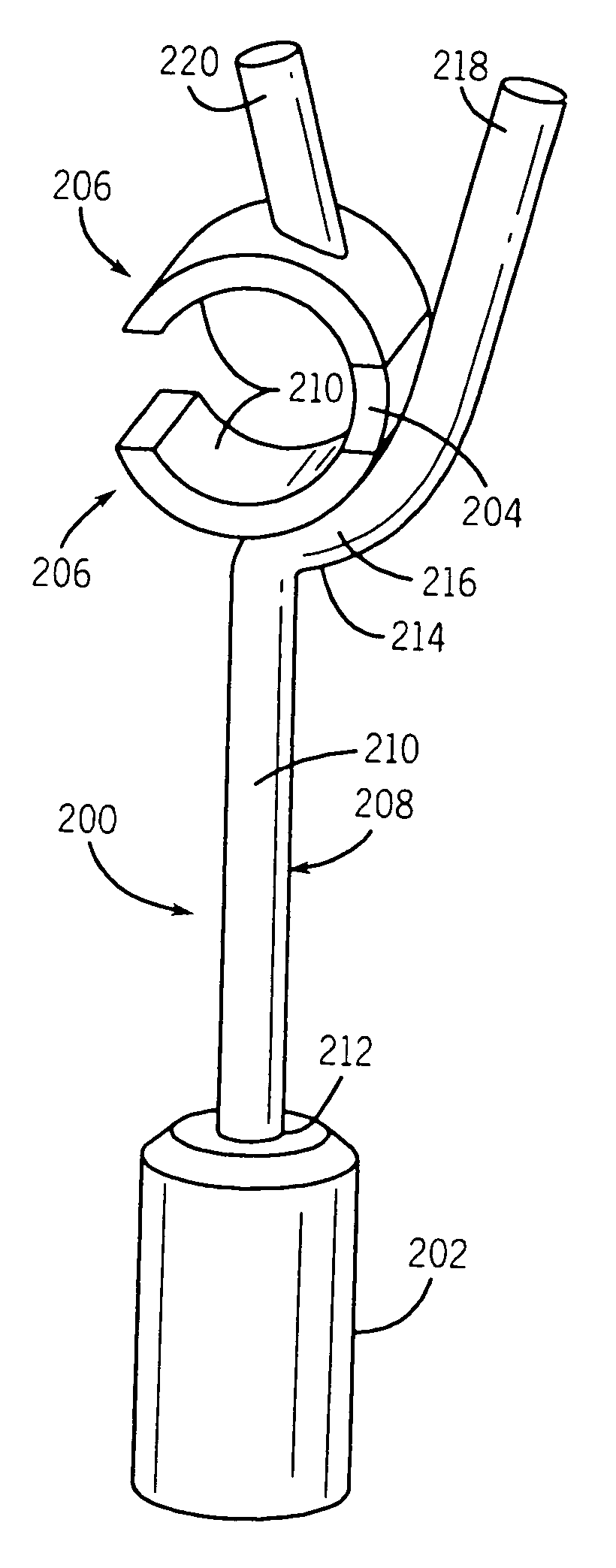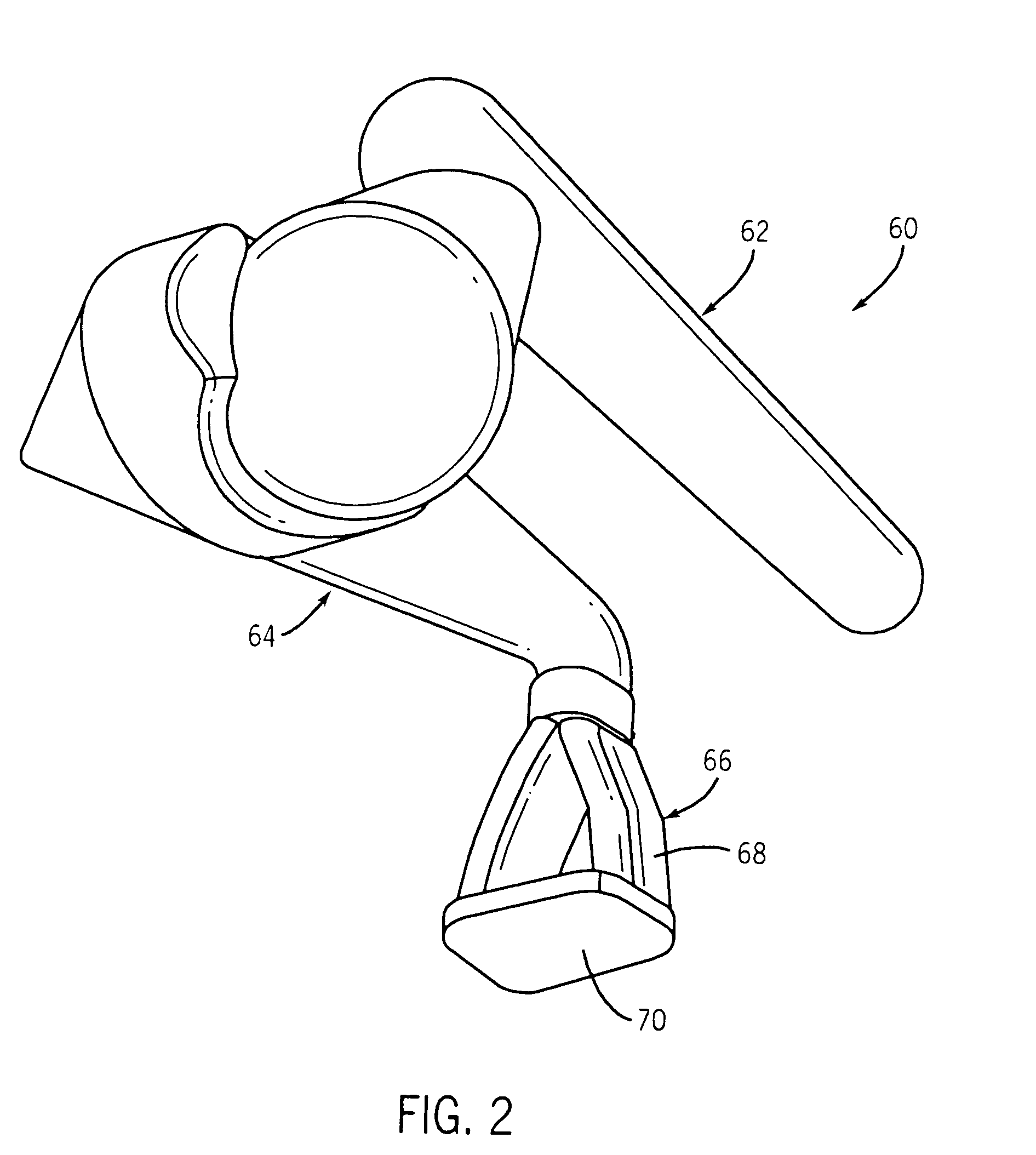Attachment mechanism for middle ear prosthesis
a technology of attachment mechanism and ossicle, which is applied in the field of ossicular prosthesis, can solve the problems of conductive hearing loss, the attachment mechanism is typically difficult to close properly around the anchoring ossicle, and the opportunity for physicians to practice the closure technique is limited
- Summary
- Abstract
- Description
- Claims
- Application Information
AI Technical Summary
Problems solved by technology
Method used
Image
Examples
first embodiment
[0018]Referring to FIG. 1, a middle ear prosthesis 20 according to the invention is illustrated. In accordance with the invention, the prosthesis 20 comprises a stapes prosthesis having a self-crimping attachment mechanism, as described below.
[0019]The prosthesis 20 includes a cylindrical piston 22 having an upwardly opening counter bore 24. The piston 20 is adapted to extend through an oval window when implanted in a human ear. A pair of jaws 26 are provided for engaging an ossicle when implanted in a human ear. A spring 28 is coupled to the jaws 26 for biasing the jaws 26 toward one another to provide clamping pressure.
[0020]The piston 22 is generally cylindrical and formed of a biocompatible material, such as titanium or polytetrafluoroethylene (PTFE). The spring 28 comprises a pair of support arms 30. The support arms 30 are identical in construction. The support arms 30 are formed of a biocompatible material and preferably are of a metal wire material having a high spring const...
second embodiment
[0028]Referring to FIG. 7, a middle ear prosthesis 100 according to the invention is illustrated. The middle ear prosthesis 100 includes a piston 102, a spring 104 and a pair of jaws 106. These elements may be formed of similar materials as with the embodiment of FIG. 1. The jaws 106 comprise semi-cylindrical bodies 108 each defining a semi-cylindrical inner surface 110. The spring 104 comprises a pair of wire support arms 112 each having a lower end 114 attached to the piston 102. Just above a mid point of the support arm 112, the wire is bent to form an arcuate portion 116. The arcuate portion 116 has a similar radius to the jaw cylindrical body 108 and is secured thereto using an adhesive or the like. The wire includes an upper tangential portion 118 extending from the arcuate portion 116 and is turned upwardly at an upper end 120. As is apparent, the two support arms 112 are offset from one another where each is connected to its associated jaw 106 so that the tangential portions...
third embodiment
[0031]Referring to FIGS. 9 and 10, a middle ear prosthesis 200 according to the invention is illustrated. The prosthesis 200 includes a piston 202, a spring 204, a pair of jaws 206 and a support arm 208 operatively coupled to one of the jaws 206 and the piston 202.
[0032]The piston 202 is similar to the piston 22, discussed above. The jaws 206 are generally similar to the jaws 106, see FIG. 7. In the third embodiment, the spring 204 comprises a flexible, spring-like coupling to connect the jaws 206. Particularly, the spring 204 may be of a silicon or pliable plastic that integrally secures the pair of jaws 206 while biasing the jaws 206 toward one another to provide clamping pressure. The jaws 206 are spaced apart so that semi-cylindrical inner surfaces 210 face one another, as shown. The spring element 204 is connected between the jaws 206 to define a substantial “C” shaped attachment mechanism. The material of the spring 204 is different from the material of jaws 206.
[0033]The supp...
PUM
 Login to View More
Login to View More Abstract
Description
Claims
Application Information
 Login to View More
Login to View More - R&D
- Intellectual Property
- Life Sciences
- Materials
- Tech Scout
- Unparalleled Data Quality
- Higher Quality Content
- 60% Fewer Hallucinations
Browse by: Latest US Patents, China's latest patents, Technical Efficacy Thesaurus, Application Domain, Technology Topic, Popular Technical Reports.
© 2025 PatSnap. All rights reserved.Legal|Privacy policy|Modern Slavery Act Transparency Statement|Sitemap|About US| Contact US: help@patsnap.com



